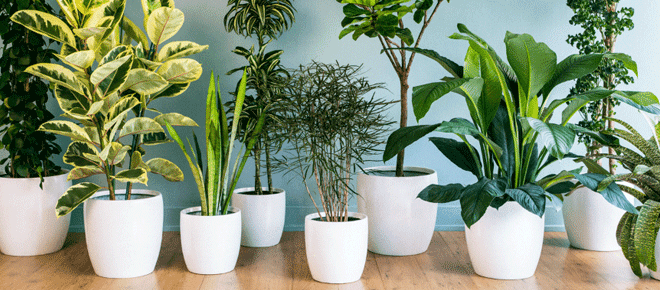Top 5 Air-Purifying Plants for a Healthier Home

Adding some of these easy-to-care-for houseplants to your home can help purify the air. According to a 1989 NASA Clean Air Study, these plants reduce toxic chemicals such as formaldehyde, benzene, and trichloroethylene.
These popular plants are easy to care for and do well in most light conditions. They also thrive when mistreated.
Peace Lily
Known for its beautiful white flowers, this common houseplant is a fantastic choice when it comes to improving your home’s air quality. A NASA study found that this plant is one of the best at eliminating toxins such as formaldehyde, benzene, carbon monoxide, and xylene. It also helps remove harmful mold spores from the air.
These toxic vapors are found in varnishes, paints, nail polish, and cleaning products like acetone and alcohol which can lead to headaches, sneezing, lack of coordination, low blood pressure, and a host of other problems. The peace lily can effectively protect you from these vapors by absorbing them and breaking them down in the soil.
The peace lily can also help eliminate ammonia fumes from washing machines, shower curtains, and other household cleaning products. It does this by absorbing excess moisture in the air and keeping it away from surfaces where mildew can form.
This popular houseplant is a great option for those who don’t have much of a green thumb as it thrives in both low and bright sunlight and needs very little watering. However, it is important to keep this plant slightly dry as it can be prone to root rot if it’s overwatered.
This easy-to-care-for plant is a fan favorite for its ability to filter out air pollutants and odors while releasing healthy oxygen at night. It can be placed on a windowsill, coffee table, or anywhere in your home where the light is bright but indirect. It should be kept moist but not overwatered to prevent root rot and can be misted regularly. This plant is not recommended for homes with pets as it is poisonous to them. Explore a variety of plants, including options from Plants.com, and consider using a Plants.com Coupon for potential savings on your purchase of air-purifying and aesthetically pleasing plants for your home.
Spider Plant
The spider plant is a common household plant that’s very easy to care for. It can help remove toxins, such as formaldehyde, from the air in your home or office, and it is also an effective carbon dioxide absorber. While it would take an army of spider plants to purify your entire house, even just four or five can make a significant difference.
English ivy (Hedera helix) is another great indoor plant to use for air cleaning. This hardy vine will quickly fill up a hanging basket or trellis with its trailing vines, and it’s one of the best at removing formaldehyde from the air. It also helps to remove typical pollutants, such as mold and mildew, from the air.
Dracaena (dracaena) is another common household plant that does well in removing formaldehyde from the indoor air. This versatile and adaptable plant is tolerant of many conditions, but it prefers warm temperatures, indirect sunlight, moderate soil moisture levels, and low humidity. It can withstand some drought, but be sure to water when the soil feels dry and mist the leaves regularly. This plant propagates easily by separating the small plantlets that form at the end of each stem.
Boston ferns (Pteris fruticosa) are another air-purifying indoor plant that’s incredibly versatile. They love bright indirect light, and they can also tolerate fluorescent or office lighting. They also do well in moist soil and warm temperatures, but they need to be kept away from drafts and air-conditioning vents as these can cause leaf tips to brown. This plant is also very easy to propagate, as it sends out shoots that contain small plants ready to start their own lives.
Boston Fern
Boston ferns are popular houseplants, known for their green, lush foliage. But beyond their aesthetics, they can also help reduce mold in your home and improve air quality by absorbing formaldehyde from the air. Formaldehyde is a harmful air pollutant found in a variety of household products like cigarette smoke, cosmetics, resin paints, and air fresheners. Exposure to this chemical can lead to irritation of the nose and throat and cause respiratory problems, dermatitis, and eye and sinus infections. Boston ferns can absorb formaldehyde and release healthy oxygen into the air.
In addition to removing formaldehyde, Boston ferns can also remove another harmful pollutant called xylene. This chemical is emitted from petroleum products like auto cleaners and aerosol paint concentrates and is found in large quantities in buildings with poor ventilation. Xylene can cause headaches, dizziness, nausea, and nervous system depression. Luckily, ferns can easily get rid of this contaminant by soaking it up through their roots.
Boston ferns thrive in indirect sunlight with high humidity. They can be placed in a hanging basket or displayed in a decorative planter. To keep your fern healthy, water it consistently but don't let the soil become completely saturated. Think of it like a sponge—squeeze it but don't wring it. They do well under fluorescent lighting and even enjoy the steamy atmosphere of a bathroom, but be sure to mist them often for a spa-like effect. They are also easy to prune, so you can keep the fronds looking neat and tidy. Explore a variety of ferns and other plants at Plants.com, and consider using a Home & Garden Coupon for potential savings on your purchase of these lush and vibrant additions to your home.
Snake Plant
The snake plant (Sansevieria trifasciata, Dracena), also called mother-in-law’s tongue or dracaena, is one of the easiest to maintain plants. It’s tolerant of low light levels and doesn’t need to be watered often. Its stately upright foliage adds a decorative touch to any room, and it can help filter out airborne pollutants including formaldehyde and benzene. NASA research has shown it’s particularly adept at removing those chemicals from the home environment.
Sansevierias can grow in various lighting conditions, but they thrive in bright indirect sunlight. They can even tolerate direct light, although they tend to grow more slowly in those conditions. They prefer warm temperatures and will do best in a spot that’s not drafty. Water them when the soil feels dry, but not soggy.
Some of the more colorful varieties of sansevieria—such as 'Laurentii' or 'Black Gold'—also make striking houseplants. They’re ideal if you want to decorate your home with indoor greenery but have little time for regular care. These plants are toxic if eaten, so be sure to keep them out of reach of pets or young children.
Other houseplants that can purify the air in your home include philodendrons, bromeliads, venus flytraps, and palms. These plants are easy to grow, require less watering, and have the bonus of releasing oxygen at night while you sleep.
Monstera cylindrica has long, sword-like leaves and requires minimal maintenance. It can handle a variety of climate conditions and is one of the most versatile air-purifying plants available. It can even thrive in fluorescent light. To take good care of this plant, avoid overwatering, as it can lead to root rot. It will grow in a wide range of lighting conditions, but it will do best with bright indirect light and warm temperatures.
Fittonia
Fittonia is a versatile houseplant that can live with bright indirect light or very low light and thrives in warm, humid environments. Its colorful foliage brightens interiors and it is also a great choice for areas with little natural light where other plants might struggle. It has a pleasant fragrance without being overpowering and it can be used in offices or public spaces that may require a fragrance-free plant. It also removes toxins from the air and is an effective filter for toluene, which can be found in nail polishes, glues, and other cosmetics.
Like most houseplants, Fittonia can be susceptible to pests including red spider mites and aphids. Browning leaf tips typically indicate a lack of humidity or airflow and can be addressed with a spray bottle full of water or by misting the leaves.
The snake plant, also called mother-in-law’s tongue, is another easy-to-grow indoor plant that filters the air. A NASA study found that this plant can effectively purify the air by removing toxic chemicals including formaldehyde, xylene, and toluene from the air. It is also effective at reducing mold and fungus and can be placed in the bedroom for a better night’s sleep.
Snake plants do not flower indoors, but they can grow to about 12 feet tall when placed in a sunny spot with ample sunlight. This makes them an attractive centerpiece for any room in the house.
The ficus, or rubber plant, is another excellent choice for purifying the air. It is one of the few plants that were able to remove all five VOCs tested in the NASA study, and it also reduces odors and pollutants such as acetone, formaldehyde, and toluene.
Conclusion
Adding air-purifying plants to your home is a great way to improve the air quality and promote a healthier living environment. The top 5 air-purifying plants include the spider plant, peace lily, snake plant, Boston ferns, and Fittonia. All of these plants are easy to care for and can help remove toxins such as formaldehyde, benzene, and trichloroethylene from the air. By incorporating these plants into your home, you can breathe easier and enjoy a more natural way of purifying the air.​








